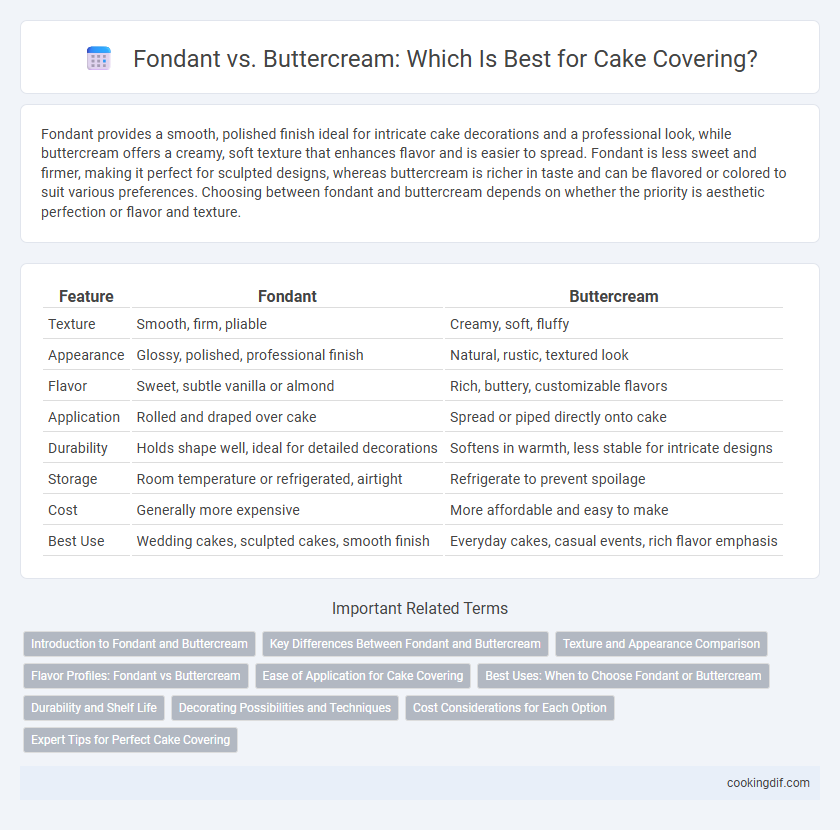Fondant provides a smooth, polished finish ideal for intricate cake decorations and a professional look, while buttercream offers a creamy, soft texture that enhances flavor and is easier to spread. Fondant is less sweet and firmer, making it perfect for sculpted designs, whereas buttercream is richer in taste and can be flavored or colored to suit various preferences. Choosing between fondant and buttercream depends on whether the priority is aesthetic perfection or flavor and texture.
Table of Comparison
| Feature | Fondant | Buttercream |
|---|---|---|
| Texture | Smooth, firm, pliable | Creamy, soft, fluffy |
| Appearance | Glossy, polished, professional finish | Natural, rustic, textured look |
| Flavor | Sweet, subtle vanilla or almond | Rich, buttery, customizable flavors |
| Application | Rolled and draped over cake | Spread or piped directly onto cake |
| Durability | Holds shape well, ideal for detailed decorations | Softens in warmth, less stable for intricate designs |
| Storage | Room temperature or refrigerated, airtight | Refrigerate to prevent spoilage |
| Cost | Generally more expensive | More affordable and easy to make |
| Best Use | Wedding cakes, sculpted cakes, smooth finish | Everyday cakes, casual events, rich flavor emphasis |
Introduction to Fondant and Buttercream
Fondant, a smooth, pliable icing made from sugar, water, and gelatin, provides a polished, professional look ideal for detailed decorative designs on cakes. Buttercream, composed of butter and powdered sugar, offers a creamy texture with rich flavor and is easier to spread and taste better for many cake enthusiasts. Choosing between fondant and buttercream depends on the desired cake appearance, texture preference, and the complexity of decoration required.
Key Differences Between Fondant and Buttercream
Fondant provides a smooth, firm, and polished finish ideal for intricate cake designs, while buttercream offers a softer, creamier texture perfect for rich flavor and easy spreading. Fondant is made primarily from sugar and water, creating a pliable dough that sets hard, whereas buttercream relies on butter or shortening blended with sugar, resulting in a lighter and more flavorful frosting. Key differences include durability, taste, and ease of decoration, with fondant excelling in detailed aesthetics and buttercream favored for taste and simplicity.
Texture and Appearance Comparison
Fondant offers a smooth, polished finish ideal for intricate cake decorating with a firm texture that holds shapes well, creating a professional appearance. Buttercream provides a soft, creamy texture that is easier to spread and can be smoothed for a slightly rustic look, enhancing flavor and moisture. Texture contrasts make fondant less creamy than buttercream, while appearance differs as fondant achieves a flawless surface and buttercream allows for more natural, varied designs.
Flavor Profiles: Fondant vs Buttercream
Fondant offers a smooth, pliable texture with a mildly sweet, neutral flavor that often highlights the cake's own taste, whereas buttercream provides a rich, creamy, and buttery flavor that enhances overall sweetness. Buttercream varieties, including Swiss meringue and Italian meringue, offer nuanced sweetness and airy textures, contrasting with fondant's dense, sugary consistency. Flavor preferences depend on the desired balance between decoration elegance and taste intensity for the cake.
Ease of Application for Cake Covering
Fondant offers a smooth, polished finish that is easier to shape and mold over cakes, making it ideal for intricate designs and clean edges. Buttercream requires careful smoothing and can be more challenging to achieve a flawless surface, especially for beginners. For quick and simple cake covering, buttercream is more forgiving while fondant demands precise application techniques.
Best Uses: When to Choose Fondant or Buttercream
Fondant excels in creating smooth, polished finishes and intricate decorations, making it ideal for wedding cakes and sculpted designs that require durability and a flawless appearance. Buttercream offers a softer, creamier texture perfect for casual celebrations, layered cakes, and flavors that benefit from a rich, buttery taste. Choose fondant for professional presentations and longer shelf life, while buttercream suits moist textures and easily customizable flavor profiles.
Durability and Shelf Life
Fondant provides a durable, smooth finish that resists moisture and maintains its shape longer than buttercream, making it ideal for elaborate cake designs exposed to varying temperatures. Buttercream, while softer and more flavorful, has a shorter shelf life and is susceptible to melting or drying out, limiting its durability, especially in warm or humid conditions. For extended preservation and structural stability, fondant-covered cakes outperform buttercream in maintaining appearance and freshness over time.
Decorating Possibilities and Techniques
Fondant offers a smooth, polished finish ideal for intricate designs like molded shapes, sharp edges, and detailed decorations, making it perfect for professional cake decorating techniques such as embossing and painting. Buttercream provides a softer texture that allows for a variety of decorating methods including piping, ruffling, and creating textured patterns, offering versatility for both rustic and elegant cake styles. The choice impacts the ease of application, stability of decorations, and the range of artistic effects achievable on the cake surface.
Cost Considerations for Each Option
Fondant generally costs more than buttercream due to its specialized ingredients and the labor-intensive process of rolling and smoothing it over cakes. Buttercream is more budget-friendly, with basic recipes requiring only butter, sugar, and flavorings, making it ideal for larger cakes or multiple layers without significantly increasing expenses. Both options vary in price depending on quality and complexity, but buttercream offers greater versatility for cost-effective cake covering.
Expert Tips for Perfect Cake Covering
Fondant provides a smooth, polished finish ideal for intricate decorations, while buttercream offers a creamy texture that is easier to flavor and adapt to varying temperatures. Experts recommend chilling the cake before applying fondant to prevent cracking, and using high-quality buttercream with a stable fat content to achieve seamless coverage. Mastering the right thickness for fondant and consistent piping pressure for buttercream ensures a flawless, professional look.
Fondant vs Buttercream for cake covering Infographic

 cookingdif.com
cookingdif.com